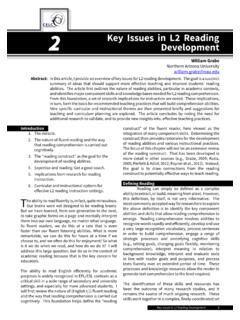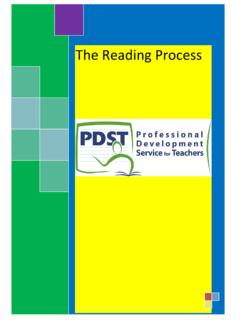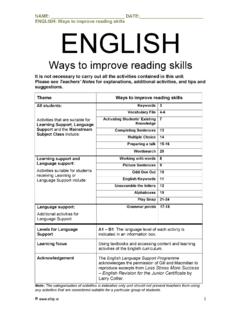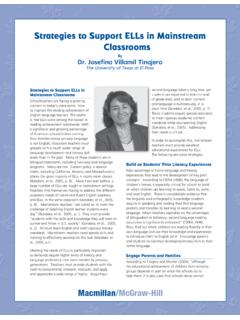Transcription of An Effective ER Program for Students with Low …
1 135 First Extensive reading World Congress Kyoto 2011 ProceedingsAn Effective ER Program for Students with Low english AbilityMAYUZUMI MichikoJuntendo M. (2012). An Effective ER Program for Students with low english ability . Extensive reading World Congress Proceedings, 1, Students enter university with insufficient english ability and low motivation for learning. Accordingly, it is necessary to improve their english ability and at the same time, motivation for learning. How Extensive reading (ER) could be Effective for this purpose will be discussed. The participants of this study were first-year university Students at the lowest of the three english levels in this Program .
2 The levels were determined by a TOEIC test given to all the first-year Students . The english class for the first-year Students was based on ER. After one year of ER, the participants reading speed increased; their comprehension improved; their TOEIC scores improved. The result of the questionnaire indicated that the Students enjoyed the course and their motivation improved. It also became clear that very easy books with less than 500 words on average are essential to an Effective ER Program for low-level , a great problem for universities accepting a considerable number of Students with low english ability is how to design a suitable Program for such Students . The Students at a low english level usually have various problems; they are weak in grammar, vocabulary, comprehension and syntax at the same time.
3 After the three-year period of trial and error, a regular textbook-based lesson composed of a little reading , listening, speaking and writing was found to be ineffective for these low-level Students . Though they learned several grammatical points and some vocabulary, they couldn t make use of what they had learned when they read or wrote. That is to say, they could not acquire a proper command of english . There was yet another problem. Many of the Students in the low-level classes were lacking in confidence and not very positive about learning english . As a whole, they were unmotivated in learning english . This is the report of a practical attempt to improve english ability and learning motivation of the low-level Students by means of extensive reading .
4 By showing what was done and how it went in this practice, it becomes clear that Extensive reading worked effectively to improve both english ability and motivation of the low-level participants in this study were 88 of 199 first-year Students in a non- english major course at a Japanese university. Those 88 Students , mainly females, were in the classes at the lowest of the three levels determined by TOEIC. Most Students in the lowest-level classes had TOEIC scores lower than 300. Procedures The 90-minute english class was held once a week for one year as a compulsory subject. In the classroom, most of the time was spent on free voluntary reading and listening. The Students chose books and books with a CD, with the help of teachers, from about 300-400 books brought in the classroom.
5 The Students were also encouraged to borrow 1-3 books from the classroom every week. Moreover, they could borrow up to 5 more books at a time from the school library. Apart from the regular voluntary reading and listening, we had a 20-minute intensive reading lesson three times. We also had assigned reading weeks; the Students were assigned to read a specific reader series for several weeks and afterwards, the Students were requested to take a quiz to answer questions about the content of the the purpose of assessing the Students progress, we gave them pre- and post- TOEIC tests, a reading speed survey with a comprehension quiz twice, and a questionnaire at the end of the year.
6 For the reading speed survey, we chose two books from Penguin Readers Easystarts. After the reading speed 136 First Extensive reading World Congress Kyoto 2011 ProceedingsMAYUZUMI MIC hIK o An Effective ER Program FoR Students with LoW english AbILItYwas measured, we collected the texts, and gave them the quiz (10 questions) to check their comprehension level. MaterialsWe have more than 4,000 books for the class use. We carried 300-400 books using a book cart to the classroom each time. For the low-level Students , very easy books (YL ) were mainly 1. Materials Used for In-Class reading (Furukawa & Kanda, 2010) reading MaterialsgR: graded Readers LR: Leveled ReadersgR: Foundations reading Library, Penguin Readers 0-1, macmillan Readers 1, oxford bookworms Library 0, Cambridge english Readers 0-1, : oxford reading tree, Longman Literacy Land, I Can Read books, Step into reading , Ready-to-Read, for Children: Elephant and Piggie Series, nate the great Series, Magic tree house Series, with CdsgR: macmillan Readers, Penguin Active reading , black Cat green Apple, oxford Classic tales, Cambridge english Readers, : I Can Read books, black Cat Earlyreads, Usborne Young reading , for Children.
7 Seuss books, JY books, Winnie the Witch Series, nate the great Series, Mercy Watson Series, Magic tree house Series, Amount of reading table 2. the Amount of reading in 2010 School YeartoEIC Scoreless than 300300-399400 or moren (199)888229 of books read (Mean)157150156 of words read (Mean)76 ,14 49 9,16 8148,560(Median)6 7, 5 8 68 9,17 313 7, 9 3 6(Max)224,9012 0 7, 8 6 4373,329(Min)19,95133,67650,360 The Students at the lowest level read almost the same numbers of books as those in other levels, and about half of the total words read by the Students with a TOEIC score of 400 or more. The lowest Students read easier books than others. toEIC Scoretable 3. Pre- and Post- toEIC Scores of the Students in the Lowest Leveln:88tot alListeningReading toEIC 1255152103toEIC 2270159111gain15*78**p<.
8 01 Though the gain might not seem large, the total and the reading scores showed a statistically significant Speed and Comprehension Leveltable 4. Comparison of the two reading Speed Surveys with Quiz testsn:88 reading Speed (w/m)Quiz Score (total:10)1st (Apr) (Jan) [Text Used] 1st: Pearl Girl (PGR0) 2nd: Good Day, Bad Day (PAR0)The average reading speed and quiz scores of the lowest-level Students were Effects of Using Easy booksFifty-eight Students of the 88 lowest-level Students read very easy, short books with fewer than 500 words. The average number of words per book was 370 (range: 177-488). Their TOEIC scores improved from 249 to 264 and showed a weak significance (p<.)
9 05), while the others who read books with more than 500 words per book did not show a significant improvement though their scores increased a little. Short, easy books with fewer than 500 words in total were Effective in improving the english ability of the lowest-level Students as suggested by Takase (2010).Results of the QuestionnaireAccording to the questionnaire given at the end of the year, 84% of Students enjoyed the course. They felt several changes in themselves. Some felt it had become more enjoyable than before to read english books (62%). Some felt it had become easier than before to read english (51%). Some felt they wanted to read more english books (44%).
10 Some felt their reading speed had become faster (41%). 137 First Extensive reading World Congress Kyoto 2011 ProceedingsMAYUZUMI MIC hIK o An Effective ER Program FoR Students with LoW english AbILItYConclusionFrom this study, it can be said that ER is Effective to improve the english ability and motivation of Students even if their TOEIC scores are less than 300. Their TOEIC scores showed a significant improvement. Their reading speed became faster and their comprehension level higher. They enjoyed reading books and became more positive toward learning english . In order to make a successful ER class for low-level Students , it is most Effective when short and easy books written with fewer than 500 words are study was supported in part by Grants-in-Aid for Scientific Research (C) (No.)









